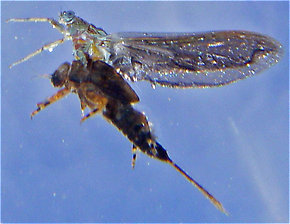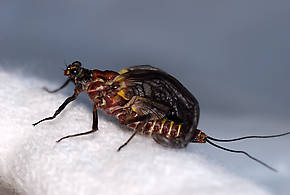Blog & Latest Updates
Fly Fishing Articles
Insects by Common Name


Mayfly Family Ephemerellidae (Hendricksons, Sulphurs, PMDs, BWOs)
Taxonomic Navigation -?-
Kingdom
Animalia (Animals)
» Phylum
Arthropoda (Arthropods)
» Class
Insecta (Insects)
» Order
Ephemeroptera (Mayflies)
» Family Ephemerellidae (Hendricksons, Sulphurs, PMDs, BWOs)
3 genera aren't included.
Common Name
| Match | Common Name |
| Hendricksons, Sulphurs, PMDs, BWOs |
This is page 13 of specimens of Ephemerellidae. Visit the main Ephemerellidae page for:
- The behavior and habitat of Ephemerellidae.
- 37 underwater pictures of Ephemerellidae.
Pictures of 271 Mayfly Specimens in the Family Ephemerellidae:
Ephemerella invaria (Sulphur Dun) Mayfly Nymph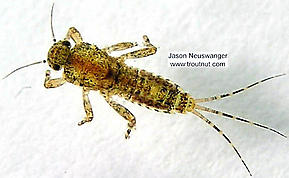 View 2 Pictures
View 2 Pictures
 View 2 Pictures
View 2 PicturesCollected January 13, 2004 from the Namekagon River in Wisconsin
Added to Troutnut.com by Troutnut on January 25, 2006
Added to Troutnut.com by Troutnut on January 25, 2006
Ephemerella subvaria (Hendrickson) Mayfly Nymph View 3 PicturesThis is one of the nymphs I collected doing something very, very strange on March 17th 2004. In the middle of the day, around 2 pm, in the water right around my feet I watched lots of Ephemerella nymphs clumsily swimming up all the way to the surface and then just kind of drifting and wiggling around in the water column. None hatched. They seemed to do it more intensely when the sun was out. It wasn't the time of day for the normal invertebrate drift phenomenon, and as far as I know invertebrate drift doesn't involve this kind of clear effort to swim all the way to the surface. I didn't need a net to catch them, I just reached down into the water and grabbed them with my fingers just below the surface.
View 3 PicturesThis is one of the nymphs I collected doing something very, very strange on March 17th 2004. In the middle of the day, around 2 pm, in the water right around my feet I watched lots of Ephemerella nymphs clumsily swimming up all the way to the surface and then just kind of drifting and wiggling around in the water column. None hatched. They seemed to do it more intensely when the sun was out. It wasn't the time of day for the normal invertebrate drift phenomenon, and as far as I know invertebrate drift doesn't involve this kind of clear effort to swim all the way to the surface. I didn't need a net to catch them, I just reached down into the water and grabbed them with my fingers just below the surface.
The prominent abdominal tubercles ( Tubercle: Various peculiar little bumps or projections on an insect. Their character is important for the identification of many kinds of insects, such as the nymphs of Ephemerellidae mayflies.) aren't quite black, though, and the general color is a dark brown, though I saw nymphs with all Hendrickson color stages behaving strangely.
Tubercle: Various peculiar little bumps or projections on an insect. Their character is important for the identification of many kinds of insects, such as the nymphs of Ephemerellidae mayflies.) aren't quite black, though, and the general color is a dark brown, though I saw nymphs with all Hendrickson color stages behaving strangely.
 View 3 PicturesThis is one of the nymphs I collected doing something very, very strange on March 17th 2004. In the middle of the day, around 2 pm, in the water right around my feet I watched lots of Ephemerella nymphs clumsily swimming up all the way to the surface and then just kind of drifting and wiggling around in the water column. None hatched. They seemed to do it more intensely when the sun was out. It wasn't the time of day for the normal invertebrate drift phenomenon, and as far as I know invertebrate drift doesn't involve this kind of clear effort to swim all the way to the surface. I didn't need a net to catch them, I just reached down into the water and grabbed them with my fingers just below the surface.
View 3 PicturesThis is one of the nymphs I collected doing something very, very strange on March 17th 2004. In the middle of the day, around 2 pm, in the water right around my feet I watched lots of Ephemerella nymphs clumsily swimming up all the way to the surface and then just kind of drifting and wiggling around in the water column. None hatched. They seemed to do it more intensely when the sun was out. It wasn't the time of day for the normal invertebrate drift phenomenon, and as far as I know invertebrate drift doesn't involve this kind of clear effort to swim all the way to the surface. I didn't need a net to catch them, I just reached down into the water and grabbed them with my fingers just below the surface.The prominent abdominal tubercles (

A few (not all) of the abdominal tubercles on this Ephemerella needhami nymph are circled. They are especially large in this species.
Collected March 17, 2004 from the Namekagon River in Wisconsin
Added to Troutnut.com by Troutnut on January 25, 2006
Added to Troutnut.com by Troutnut on January 25, 2006
Ephemerella aurivillii Mayfly Nymph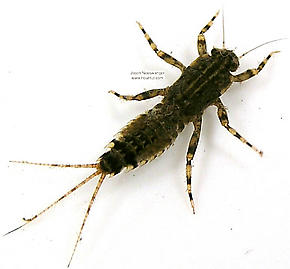 View 3 Pictures
View 3 Pictures
 View 3 Pictures
View 3 PicturesCollected February 5, 2004 from unknown in Wisconsin
Added to Troutnut.com by Troutnut on January 25, 2006
Added to Troutnut.com by Troutnut on January 25, 2006
Ephemerellidae (Hendricksons, Sulphurs, PMDs, BWOs) Mayfly Nymph View 2 PicturesClose examination of this specimen under a microscope reveals that it has small rounded tubercles (
View 2 PicturesClose examination of this specimen under a microscope reveals that it has small rounded tubercles ( Tubercle: Various peculiar little bumps or projections on an insect. Their character is important for the identification of many kinds of insects, such as the nymphs of Ephemerellidae mayflies.) on the tergites (
Tubercle: Various peculiar little bumps or projections on an insect. Their character is important for the identification of many kinds of insects, such as the nymphs of Ephemerellidae mayflies.) on the tergites (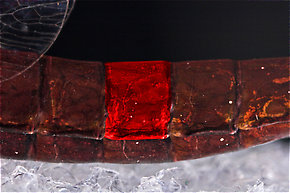 Tergite: The top (dorsal) part of a single segment on an insect's abdomen when it consists of a single chitinous plate (sclerite), or an individual sclerite if the segment has more than one.) and the tails are uniformly covered with short black hairs. Looking at this specimen a while later, my early observations were probably not relevant because it was such as small early instar (Instar: Many invertebrates molt through dozens of progressively larger and better-developed stages as they grow. Each of these stages is known as an instar. Hard-bodied nymphs typically molt through more instars than soft-bodied larvae.) mayfly that its identifying characteristics were not fully developed.
Tergite: The top (dorsal) part of a single segment on an insect's abdomen when it consists of a single chitinous plate (sclerite), or an individual sclerite if the segment has more than one.) and the tails are uniformly covered with short black hairs. Looking at this specimen a while later, my early observations were probably not relevant because it was such as small early instar (Instar: Many invertebrates molt through dozens of progressively larger and better-developed stages as they grow. Each of these stages is known as an instar. Hard-bodied nymphs typically molt through more instars than soft-bodied larvae.) mayfly that its identifying characteristics were not fully developed.
 View 2 PicturesClose examination of this specimen under a microscope reveals that it has small rounded tubercles (
View 2 PicturesClose examination of this specimen under a microscope reveals that it has small rounded tubercles (
A few (not all) of the abdominal tubercles on this Ephemerella needhami nymph are circled. They are especially large in this species.

One tergite of this Isonychia bicolor mayfly spinner is highlighted in red.
Collected January 31, 2004 from unknown in Wisconsin
Added to Troutnut.com by Troutnut on January 25, 2006
Added to Troutnut.com by Troutnut on January 25, 2006
Ephemerella aurivillii Mayfly Nymph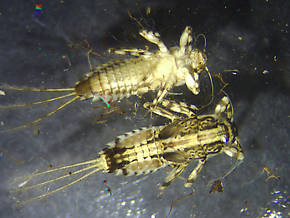 View 3 PicturesI have collected this species in Montana but it is very common in Alaska streams.
View 3 PicturesI have collected this species in Montana but it is very common in Alaska streams.
 View 3 PicturesI have collected this species in Montana but it is very common in Alaska streams.
View 3 PicturesI have collected this species in Montana but it is very common in Alaska streams.Collected June 19, 2010 from the Kwethluk River in Alaska
Added to Troutnut.com by Bnewell on June 26, 2011
Added to Troutnut.com by Bnewell on June 26, 2011
Ephemerella dorothea infrequens (Pale Morning Dun) Mayfly Nymph View 2 PicturesHabitat: Shallow riffle over cobble; approx. 1 ft. deep
View 2 PicturesHabitat: Shallow riffle over cobble; approx. 1 ft. deep
Size: 8.5 mm. Mature specimens have been captured as large as 10.5 mm.
Emergence schedule: Variable - starting as early as mid March and lasting as late as early June, depending on the year. Usual duration is at least several weeks or more.
Dun Association: Body is elusive pale creamy yellow w/ orange highlights, cream legs and tails, and dun wings
Specimen status in photo: Preserved
Collection method: Kick net
Comments: Extremely common in samples taken from this location. It's color in life was very close to as depicted in the photo; except for the gradual darkening of the abdominal segments as they progress posteriorly, which has been accentuated somewhat by the effects of preservation. Adult association is based upon capture of this taxon at various stages of emergence including: darkened wingcases, split thoraxic notums, and partially ecloded or ''stillborn (Stillborn: In fly fishing, a stillborn insect is one which got stuck in its nymphal or pupal shuck during emergence and floats helplessly on the surface instead of flying away. It is a specific class of cripple, although it is sometimes used interchangeably with that term.)'' specimens.
Entoman
 View 2 PicturesHabitat: Shallow riffle over cobble; approx. 1 ft. deep
View 2 PicturesHabitat: Shallow riffle over cobble; approx. 1 ft. deepSize: 8.5 mm. Mature specimens have been captured as large as 10.5 mm.
Emergence schedule: Variable - starting as early as mid March and lasting as late as early June, depending on the year. Usual duration is at least several weeks or more.
Dun Association: Body is elusive pale creamy yellow w/ orange highlights, cream legs and tails, and dun wings
Specimen status in photo: Preserved
Collection method: Kick net
Comments: Extremely common in samples taken from this location. It's color in life was very close to as depicted in the photo; except for the gradual darkening of the abdominal segments as they progress posteriorly, which has been accentuated somewhat by the effects of preservation. Adult association is based upon capture of this taxon at various stages of emergence including: darkened wingcases, split thoraxic notums, and partially ecloded or ''stillborn (Stillborn: In fly fishing, a stillborn insect is one which got stuck in its nymphal or pupal shuck during emergence and floats helplessly on the surface instead of flying away. It is a specific class of cripple, although it is sometimes used interchangeably with that term.)'' specimens.
Entoman
Collected March 21, 2011 from the Lower Yuba River in California
Added to Troutnut.com by Entoman on November 1, 2011
Added to Troutnut.com by Entoman on November 1, 2011
Female Drunella grandis (Western Green Drake) Mayfly Dun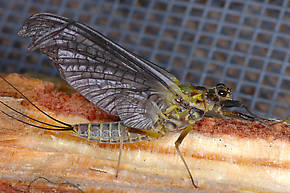 View 3 Pictures
View 3 Pictures
 View 3 Pictures
View 3 PicturesCollected June 29, 2007 from the Jocko River in Montana
Added to Troutnut.com by Bnewell on June 28, 2011
Added to Troutnut.com by Bnewell on June 28, 2011
Ephemerella subvaria (Hendrickson) Mayfly Nymph View 2 PicturesHere's another of the nymphs I collected behaving strangely, as described for this specimen.
View 2 PicturesHere's another of the nymphs I collected behaving strangely, as described for this specimen.
 View 2 PicturesHere's another of the nymphs I collected behaving strangely, as described for this specimen.
View 2 PicturesHere's another of the nymphs I collected behaving strangely, as described for this specimen.Collected March 17, 2004 from unknown in Wisconsin
Added to Troutnut.com by Troutnut on January 25, 2006
Added to Troutnut.com by Troutnut on January 25, 2006
Drunella coloradensis (Small Western Green Drake) Mayfly Nymph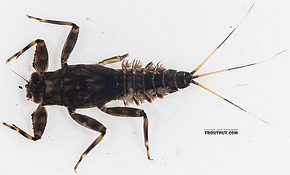 View 11 PicturesThis one nicely illustrates the variation in coloration within an single Ephemerellid species in a single stream, when compared to its lighter, banded counterpart.
View 11 PicturesThis one nicely illustrates the variation in coloration within an single Ephemerellid species in a single stream, when compared to its lighter, banded counterpart.
 View 11 PicturesThis one nicely illustrates the variation in coloration within an single Ephemerellid species in a single stream, when compared to its lighter, banded counterpart.
View 11 PicturesThis one nicely illustrates the variation in coloration within an single Ephemerellid species in a single stream, when compared to its lighter, banded counterpart.Collected July 25, 2019 from Mystery Creek #249 in Washington
Added to Troutnut.com by Troutnut on July 26, 2019
Added to Troutnut.com by Troutnut on July 26, 2019
Top 10 Fly Hatches
Top Gift Shop Designs
Eat mayflies.
Top Insect Specimens
Miscellaneous Sites
Troutnut.com is copyright © 2004-2024 Jason
Neuswanger (email Jason). See my FAQ for information about use of my images.
 privacy policy
privacy policy

